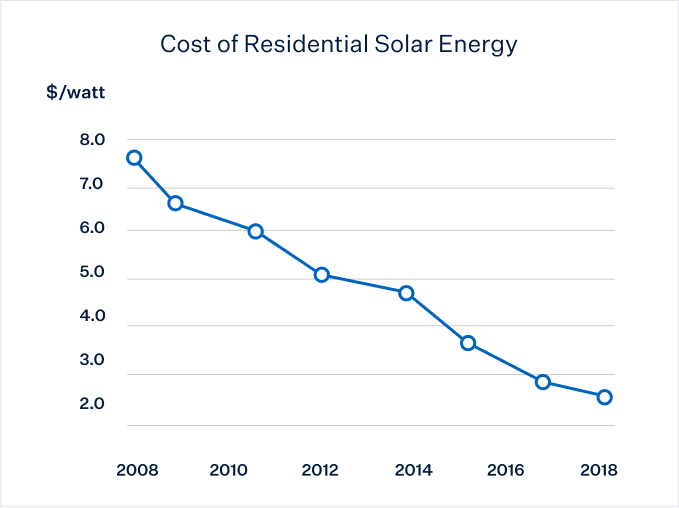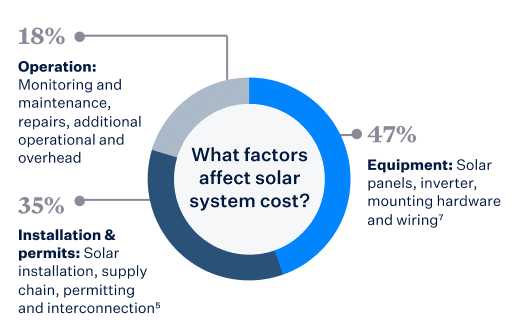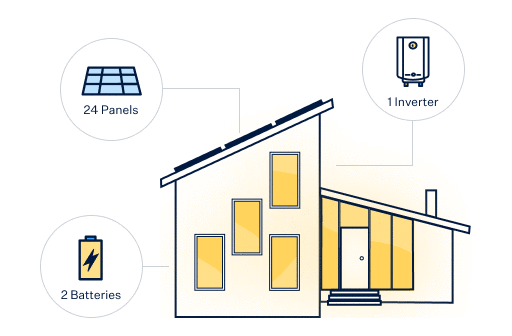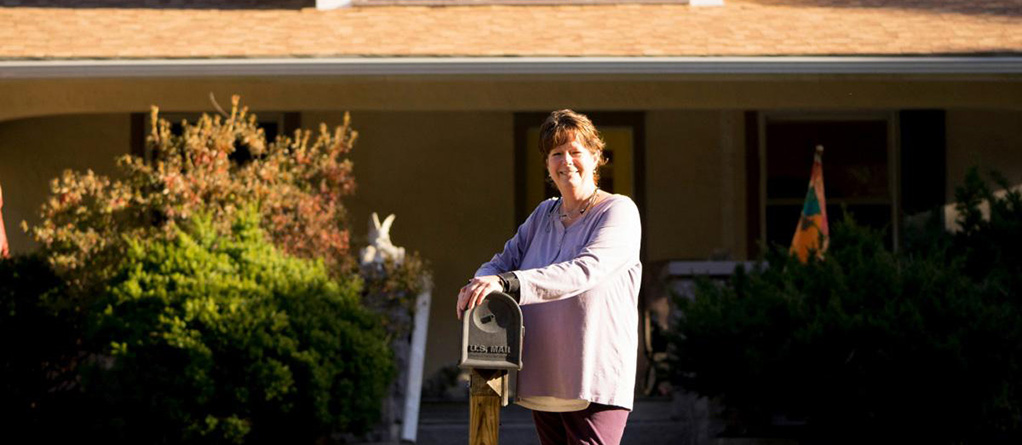
Cost of solar in 2021
The cost of solar has dropped significantly in the past several years. A decade ago, an average 6 kilowatt hour residential solar system could cost more than $50,000. Now, the outright cost of a typical home installation ranges from $16,200 to $21,400, which is a 62% average annual decrease.2
From the price of hardware to ongoing maintenance, learn more about the cost of home solar.
See the cost of solar for your home today
Average cost of residential solar keeps falling
Solar panels are rapidly spreading over American rooftops. And as the cost of solar continues to fall, it’s no surprise that residential solar systems are installed every 100 seconds in the United States.1 Residential solar costs are at their lowest in over 30 years. More affordable than ever, today’s residential solar panels feature technology advances that maximize power production.
Average cost of residential solar keeps falling. Residential solar costs are at their lowest in over 30 years. More affordable than ever, today’s residential solar panels feature technology advances that maximize power production.

How much does the average solar system cost?
| System size | Capacity (kW) | Cost |
|---|---|---|
| Average | 4kW | $15,000 |
| Large | 8kW | $29,000 |
Note: ***The above numbers are national averages.
It's a Great Time for Solar

- Find the ideal system and battery
- Get your costs to make the switch
- Check your potential savings
- Learn about solar incentives

Customer Testimonials
“Having solar panels has given me reassurance that my bills will stay manageable.”
— Kerrie Lane, Egg Harbor City, NJ
With Sunrun, you can take control of your own electricity, and not be left at the whims of your utility company with the next inevitable rate hike. Join the more than a quarter of a million American households who have gone solar with Sunrun.
Whenever you’re ready, our solar advisors are here to help. We can provide you with a free quote. Feel free to try our Cost of Solar Calculator.
What factors affect solar system cost?
A single solar panel costs between $2.67 and $3.43 to buy and install.4 The price of the whole system is based on its capacity, measured in watts. How big a system you need will be based on how much energy you use, your roof’s sunlight exposure and panel efficiency.
The amount you save will rely on several factors, including:18
- Region’s sunlight exposure
- Cost of solar system (including battery, where available)
- Cost of electricity
- Energy use
- Local rebates and incentives
Source: https://www.nerdwallet.com/blog/finance/save-money-putting-solar-panels-...
The average payback period for a residential solar system is between six to nine years, depending on the cost of your system, incentives and savings from your energy bill.19
Here’s a closer look at some of the things that determine your system costs.
Installation
Here’s a breakdown of installation costs, based on findings from the National Renewable Energy Laboratory:10
| Category | Cost Breakdown |
|---|---|
| Labor | $0.30 per watt |
| Panels | $0.47/Wdc |
| Inverter | $0.12/Wdc - $0.39/Wdc |
| Permit/Inspection | $0.06/Wdc |
| Structural BOS | $0.10/Wdc |
| Electrical BOS | $0.19–$0.27/Wdc (Varies by inverter option) |
| Sales tax | Sales tax varies by location; weighted national average: 6.9% |
| Electrician | $19.74–$38.96 per hour (Varies by location and inverter option) |
| Laborer | $12.88–$25.57 per hour (Varies by location and inverter option) |
| Burden rates | (% of direct labor) Total nationwide average: 31.8% |
Source: https://www.nrel.gov/docs/fy19osti/72399.pdf
*Figures based on the average 6.2 kilowatt residential solar system.
**Wdc: Watts direct current
These figures are based on the average 6.2 kilowatt solar system. The cost of each system will vary based on panel manufacturer, inverter option, location and equipment.
Maintenance
Maintenance of solar panels ranges from routine cleaning to major repairs. On average, households pay $150 for one solar panel cleaning.11 Companies charge between $3 to $10 per panel based on roof slant, home height and system size.11 Some firms charge a flat rate fee for a system cleaning. If you clean your system twice a year, as recommended, you can expect an annual bill of about $300.
If your system is damaged, you may incur additional expenses. Repairs to your system will include the prices of equipment and labor. Labor is typically priced at $100 per hour. Materials for solar repairs could be as little as $180 but may also be greater than $1,000. Your combined, total bill may range from $200 to $3,000.11
The four most common types of damage to a home solar system and the costs of repairs area:11
| Category | Cost Breakdown |
|---|---|
| Broken glass panel | $20 – $350, plus labor |
| Cracked panel | $100 – $400+ |
| Loose connection | $100+ |
| Replacement inverter | $100 – $2,500 |
Like cleaning costs, the amount you pay for repairs is affected by things like roof steepness, system type and system size. And if your panels have extensive damage, it may be cheaper to replace them.11
When you own your system, you are responsible for the cost of maintenance and repairs. Your warranty should cover specific system failures; contact your installer before you begin repairs. A Sunrun solar lease, lets you save thousands of dollars in maintenance and repairs. You simply pay for the power, and we take care of the rest. Our comprehensive service package features the Sunrun Guarantee, which includes best-in-class monitoring, free equipment replacement, and system repairs including parts and labor, and routine maintenance.
If you’re set on buying your own home solar system, you can also purchase our full-service package, Protection Plus. While the system is yours, we’ll give you the same comprehensive support that comes with our Sunrun Guarantee.
Panel manufacturer
The price of your panels will depend on the manufacturer. Sunrun partners with LG, a world leader in solar technology and panels. Striking the right balance between quality, efficiency and affordability, LG offers some of the best solar panels on the market today.14
For a given manufacturer, higher efficiency panels cost more.5 The good news is that the highest efficiency panels aren’t always needed, especially if your roof gets plenty of sun.
Your state
Another factor in determining your total home solar system cost is where you live. Here are the states with the lowest and highest average solar system costs:*
| Least expensive solar install | Most expensive solar install |
|---|---|
| Florida: $9,198 – $11,970 | Rhode Island: $13,104 – $15,792 |
| Arizona: $10,332 – $12,096 | New York: $12,264 – $16,044 |
| Maryland: $10,332 – $12,768 |
Source: https://news.energysage.com/how-much-does-the-average-solar-panel-instal...
Prices after 30% federal solar tax credit 5
Just because a residential solar system costs more in a given state doesn’t mean it’s any less cost effective.5 Local incentives can make a huge dent in solar installation costs even in the most expensive states.
Hardware options
| Solar panel type | Description |
|---|---|
| Monocrystalline | Monocrystalline are the most efficient on the market today, which means you need less panels to fulfill your energy needs. Monocrystalline solar cells are single-crystal silicon, giving electrons greater freedom to move and create electricity.7 These panels are typically black, giving your roof a sleeker aesthetic. Monocrystalline panels also maintain their efficiency for longer and usually come with a 20 to 25 year guarantee.6 |
| Polycrystalline | Polycrystalline panels are made with many fragments of silicon.7 While this makes them less efficient, it creates less waste in production and are more affordable.6 They also tend to have a blue tint, likely the most recognizable feature of solar panels today. |
| Thin-film | Unlike monocrystalline and polycrystalline panels, thin-film isn’t made of silicon. Instead, it’s layered with photovoltaic materials on metal or glass.8 While the least expensive option, thin-film isn’t as efficient and likely won’t cover the average household’s energy needs without taking up lots of space.6 |
The type of solar panel you choose will factor into the price of the system. But remember that if you decide to lease, you’ll be paying for the power rather than the panels. The cost of solar will come down to the amount of solar power you’re projected to use under your lease agreement.
Solar panel mount types
While solar panels are the main component of a solar system, how you mount the panels will also affect the cost. There are three mount types:6
| Mount type | Cost | Description |
|---|---|---|
| Fix-mount | $10–$15 per mount | Fixed-mount are stationary and can’t be moved to capture more sunlight, making them less efficient than other mounts. However, they’re also the least expensive. In addition, states with consistent sunlight such as Arizona and California are the least affected by this. |
| Adjustable-mount | $50 per mount | Adjustable-mounts can be tilted to maximize solar energy production. This mount type can also lay your panels flat during a storm to avoid wind damage. While they’re more expensive than fixed mounts, adjustable-mounts might make the most sense for regions with more seasonal climates and less space to maximize energy production. |
| Tracking-mount | $500–$3,000 per mount | Tracking-mount follows the sun’s arch for maximum energy production. Even though they’re the most expensive, track-mounting could add 45% in energy production and might be worth considering based on your location. However, track mounting also requires more attention and will be much more costly to maintain. |
Source: https://www.homeadvisor.com/cost/heating-and-cooling/install-solar-panels/
Incentives
Local incentives like tax credits, rebates, local electricity rates, net energy metering (NEM) and the direction of your roof can help shorten your solar panel payback period and maximize your savings.4
Federal solar tax credits
The federal solar tax credit can reduce the purchase and installation costs of a new home solar system. Currently, the federal solar tax credit gives you a dollar-for-dollar reduction against your federal income tax equal to 26% of the final cost of solar energy systems as long as the home solar system is installed by December 31, 2022. Starting in 2023, the tax credit will step down to 22%. After 2023, the tax credit for residential solar ends.15,16
In the meantime, you can apply for federal solar tax credits by filling out forms 5695 and 1040 on your tax returns.17 Sunrun is always available to help you simplify the process. We will make sure that your bottom-line expenses come in the form of a low, predictable monthly payment. Learn more about federal solar incentives.
Local solar incentives
In addition to the federal solar tax credit, some states offer additional tax credits for installing home solar systems. These programs enable you to deduct a portion of your system’s cost from your state tax bill, similar to federal solar tax credit. Individual state may also offer solar rebates.
Why Sunrun
Every home is different and your electricity demands are unique. Our experts are here to help you. Sunrun designs, installs, finances, insures, monitors and maintains solar home solar systems, while families receive predictable pricing for 20 years or more. As the nation’s largest residential solar, battery storage and energy services company, we provide families with industry-leading service, products and financing options to be able to meet different peoples’ needs. Our solar leases offer the financial value and flexibility you deserve.
Frequently Asked Questions
The up-front cost of a typical home installation ranges from $16,200 to $21,400. Your bottom line will also be determined by maintenance costs and tax credits and other incentives. Your net savings will vary by region and by the amount of electricity you use.
Solar panels need to be maintained over time. This includes periodic cleaning and repairs. It is recommended that panels be cleaned twice annually at an average cost of $150 per cleaning. Any needed repairs will add to the cost. The combined costs of equipment and labor can range from $200 to as much as $3,000.11
When you own your system, you are responsible for the cost of maintenance and repairs. Alternatively, a Sunrun solar lease lets you only pay only for the power. We handle the maintenance ourselves so you don’t have to worry about it.
Tax credits and other incentives can help reduce your costs by thousands of dollars. The federal solar tax credit is one of the best solar incentives out there. Many states offer additional incentives that allow you to deduct a portion of your system’s cost from your state tax bill, similar to federal solar tax credit. Solar rebates are also available in some states.
Consult with a tax professional to understand the credits you’re eligible for. With Sunrun, you can also set it and forget it when you lock in 25 years of affordable solar power with just one upfront payment. From paperwork to installation to maintenance, we take care of the rest.
Sources:
1. https://www.seia.org/solar-industry-research-data
2. https://www.solar-estimate.org/news/how-has-the-price-and-efficiency-of-...
3. http://money.com/money/5229935/when-to-install-home-solar-panels/
4. https://news.energysage.com/how-much-does-the-average-solar-panel-instal...
5. https://news.energysage.com/how-much-does-the-average-solar-panel-instal...
6. https://www.homeadvisor.com/cost/heating-and-cooling/install-solar-panels
7. https://www.energysage.com/solar/101/monocrystalline-vs-polycrystalline-...
8. https://news.energysage.com/thin-film-solar-panels-make-sense/
9. https://news.energysage.com/6kw-solar-system-compare-prices-installers/
10. https://www.nrel.gov/docs/fy19osti/72399.pdf
11. https://www.homeadvisor.com/cost/cleaning-services/solar-panel-maintenance/
12. https://energyinformative.org/solar-panel-cleaning/
13. https://www.nrel.gov/docs/fy12osti/51664.pdf
14. https://news.energysage.com/best-solar-panels-complete-ranking/
15. https://www.seia.org/initiatives/solar-investment-tax-credit-itc
16. https://www.nrel.gov/docs/fy18osti/70384.pdf
17. https://news.energysage.com/how-do-i-claim-the-solar-tax-credit/
18. https://www.nerdwallet.com/blog/finance/save-money-putting-solar-panels-...
19. https://energycenter.org/solar/homeowners/cost
20. https://www.usnews.com/news/articles/2016-03-31/when-will-rooftop-solar-...
21. https://www.eia.gov/energyexplained/electricity/prices-and-factors-affec...
22. https://www.eia.gov/outlooks/steo/report/electricity.php
23. http://news.mit.edu/2018/explaining-dropping-solar-cost-1120
24. https://www.greentechmedia.com/articles/read/report-levelized-cost-of-en...
25. https://www.sunrun.com/go-solar-center/solar-articles/how-much-solar-pow...
26. http://eta-publications.lbl.gov/sites/default/files/lbnl-6942e-fullrepor...